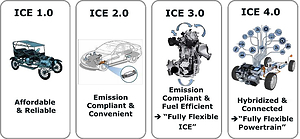Current issue
Online first
Archive
About the Journal
Aims and scope
Publisher and Editorial
Advertising policy
For Authors
Paper review procedures
Procedures protecting authentic authorship of papers
Paper preparation manual
Plagiarism check
Publication ethics
Reviewers
APC
Editorial and Scientific Board
Contact
Reviewers
Highest efficiency and ultra low emission – internal combustion engine 4.0
1
AVL List GmbH
Submission date: 2019-09-27
Final revision date: 2019-12-17
Acceptance date: 2020-01-18
Publication date: 2020-03-30
Combustion Engines 2020,180(1), 8-16
KEYWORDS
TOPICS
ABSTRACT
In the future, the simultaneous reduction of pollutant and CO2 emissions will require significantly enhanced powertrain functionalities that cannot only be adequately represented by the ICE (internal combustion engine) alone. Both automated transmissions and especially powertrain electrification can help to meet efficiently those extended requirements. The extended functionalities are no longer applied exclusively with the ICE itself ("Fully Flexible Internal Combustion Engine"), but distributed across the entire powertrain ("Fully Flexible Powertrain"). In addition, the powertrain will be fully networked with the vehicle environment and thus will utilize all data that are useful for emission and consumption-optimized operation of the ICE.
Combustion engine and electrification often complement each other in a synergetic way. This makes it extremely sensible for the combustion engine to evolve in future from a "single fighter" to a "team player". If one compares the requirements of such an ICE with the definition of Industry 4.0, then there are extensive correspondences. Thus, it seems quite opportune to call such a fully networked combustion engine designed to meet future needs as “Internal Combustion Engine 4.0 (ICE 4.0)”. This even more so, as such a name can also be derived from the history: e.g. ICE 1.0 describes the combustion engines of the first mass-produced vehicles, ICE 2.0 the combustion engines emission-optimized since the 1960s and ICE 3.0 the highly optimized "Fully Flexible Combustion Engine", which currently offers a high torque and performance potential combined with low fuel consumption and pollutant emissions.
In addition to further improvements in fuel consumption, the "Combustion Engine 4.0" offers such a low level of pollutant emissions that can best be described as "Zero Impact Emission". This means that such future ICE´s will no longer have a negative impact on the imission situation in urban areas. With the e-fuels topic, the ICE also has the potential to become both CO2- and pollutant-neutral in the medium and long term. This means that the ICE – also in passenger cars – will continue to be an essential and necessary cornerstone for future powertrain portfolios for the next decades.
REFERENCES (6)
1.
LIST, H.O. Antriebssysteme im Wandel. 39. Internationales Wiener Motorensymposium 2018.
2.
Bundesministerium für Wirtschaft und Energie; Bundesministerium für Bildung und Forschung; Plattform Industrie 4.0: Was ist Industrie 4.0?, https://www.plattform-i40.de/I..., 2018.
3.
KUFFERATH, A., KRÜGER, M., NABER, D. et al. Der Diesel Powertrain auf dem Weg zu einem vernachlässigbaren Beitrag bei den NO2-Immissionen in den Städten. 39. Internationales Wiener Motorensymposium 2018.
4.
COMMISSION REGULATION (EU) …/… of XXX amending Directive 2007/46/EC, Commission Regulation (EC) No. 692/2008 and Commission Regulation (EU) 2017/1151 for the purpose of improving the emission type approval tests and procedures for light passenger and commercial vehicles, including those for in-service conformity and real-driving emissions and introducing devices for monitoring the consumption of fuel and electric energy (Ares (2018)1297632).
5.
SCHÖFFMANN, W., SORGER, H., WEISSBÄCK, M., Effiziente und kostenoptimierte Antriebseinheit für 48V-Systeme“. MTZ. 2017, 5.
6.
PELS, T., DAVYDOV, V., ELLINGER, R. et al. 48V – where to place the e-machine?. 11th International MTZ Conference on Future Powertrains, 2017.
CITATIONS (6):
1.
World-wide trends in powertrain system development in light of emissions
legislation, fuels, lubricants, and test methods
Piotr BIELACZYC, Joseph WOODBURN, Ameya JOSHI
Combustion Engines
Piotr BIELACZYC, Joseph WOODBURN, Ameya JOSHI
Combustion Engines
2.
The possibility of energy consumption reduction using the ECO driving mode based on the RDC test
Wojciech Cieślik, Filip Szwajca, Jacek Golimowski
Combustion Engines
Wojciech Cieślik, Filip Szwajca, Jacek Golimowski
Combustion Engines
3.
Reverse Engineering of Research Engine Cylinder-Head
Wojciech Cieślik, Filip Szwajca, Krzysztof Wisłocki
Combustion Engines
Wojciech Cieślik, Filip Szwajca, Krzysztof Wisłocki
Combustion Engines
4.
The Research and Impact Evaluation of Eco-Driving Strategy on Specific Energy Consumption in a Passenger Vehicles
Piotr Gorzelańczyk, Piotr Piątkowski
Communications - Scientific letters of the University of Zilina
Piotr Gorzelańczyk, Piotr Piątkowski
Communications - Scientific letters of the University of Zilina
5.
Research on low-emission vehicle powered by LPG using innovative hardware and software
Arkadiusz Małek, Jacek Caban, Branislav Sarkan
The Archives of Automotive Engineering – Archiwum Motoryzacji
Arkadiusz Małek, Jacek Caban, Branislav Sarkan
The Archives of Automotive Engineering – Archiwum Motoryzacji
6.
The hybrid concept of turboshaft engine working according to Humphrey cycle dedicated to variety power demand – CFD analysis
Piotr Tarnawski
Combustion Engines
Piotr Tarnawski
Combustion Engines
Share
RELATED ARTICLE
We process personal data collected when visiting the website. The function of obtaining information about users and their behavior is carried out by voluntarily entered information in forms and saving cookies in end devices. Data, including cookies, are used to provide services, improve the user experience and to analyze the traffic in accordance with the Privacy policy. Data are also collected and processed by Google Analytics tool (more).
You can change cookies settings in your browser. Restricted use of cookies in the browser configuration may affect some functionalities of the website.
You can change cookies settings in your browser. Restricted use of cookies in the browser configuration may affect some functionalities of the website.



